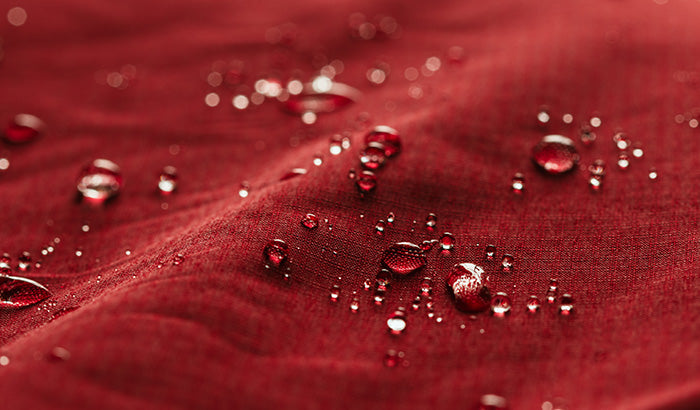What's New at Wazoodle
What's New

Shopping for waterproof fabric is easier if you know what to look for. Having a comprehensive guide to the different types of materials is just what you need. And that’s exactly what today’s blog is all about – five things to look for when purchasing waterproof fabric.
Keep reading to learn more about waterproof fabric!
We’d like to start by defining the term “waterproof.” Waterproof fabric is impermeable; water can’t get through it. Many individuals look for waterproof fabric for raincoats, tents, and umbrellas. Some parents look for waterproof materials for diapers, while some need waterproof material for incontinence applications. The reasons vary, but the fabric’s impermeability to water is what most people need.
Waterproof fabric is made of an outer layer of material with a laminated coating. The membranes in the fabric are small enough that water can’t get in, but sweat and air can get out! This is important; you want a breathable waterproof fabric, or your fabric will quickly smell from trapping everything!
While these terms are used interchangeably, they are not the same. Waterproof fabrics won’t allow water to penetrate through. Water-resistant and water-repellent fabrics only protect the top layer. They can hold up somewhat well, but not like a waterproof fabric that works at every level of fabric.
Water-resistant and water-repellant fabrics are made using a topical surface finish, so they fade away over time as the product is washed, leaving you with a base fabric with no water-resistant or water-repellant features.
So, when you look for waterproof fabric, check to see which label it has. Make sure you get what you need!
Using oil or wax – both of which are water-repellent – was one of the first ways to achieve a waterproof fabric. Of course, things have evolved since then! Now, we use paraffin, silicone, beeswax, or soy-based oils to achieve the same result.
There are some pros and cons to these waterproof fabrics. They last a long time and are easy to repair, but they’re cumbersome and not the best waterproof choice. While they certainly are waterproof, other options are more waterproof.
If you’re looking for durable, easy-to-repair fabric, try a waxed or oiled fabric.
A rubberized fabric is made of milk that comes from rubber trees. This form of waterproofing dates back to the early 1800s when Charles Macintosh figured out how to harvest rubber milk to achieve a waterproof fabric. This method is still used today, although harvesting methods have evolved.
Rubberized fabrics are incredibly waterproof and can be worn in almost any situation. If you choose a rubberized fabric, remember that it tends to be heavier and stiffer than other waterproof fabrics and comes with low breathability. It’s not ideal for running a marathon!
Consider rubberized fabric if you’re looking for a waterproof fabric that won’t give in to the rain.
PUL fabrics are laminated with TPU - thermoplastic polyurethane film, which is waterproof and will not allow water through. There are two ways of making PUL fabrics. You can laminate one side to make a 2-Layer PUL or you can laminate the TPU film in between 2 fabric layers to make a 3-Layer PUL.
If you want a waterproof plush blanket, you’ll most likely want it laminated on just one side so that you can enjoy the soft side. A three-layer PUL or CORE PUL fabric is best if you want the waterproof layer hidden between two layers of fabric.
If you want a wide variety of fabrics to choose from, go for a PUL fabric since just about any fabric can be laminated to make it waterproof.
Polyester and nylon are well known for their hydrophobic qualities. For some of the woven polyester and nylons like the Nylon Ripstop; the fabrics’ weaving is tight enough that water can’t get through. Because they’re commonly used and readily available, woven polyester and nylons are very affordable.
Oilcloth is made of tightly woven linen or cotton duck cloth coated with linseed oil and then covered with clear vinyl for double the protection.
Oilcloth is easy to clean and can stand up to dirt and grime. It’s also heavy, making it ideal for luggage and tote bags. But it’s not just for the travel or handbag industry. Medical settings also use oilcloth for waterproof mattress covers, which are essential for incontinence.
Microfiber is water-resistant on its own and waterproof with a PUL coating. Its water resistance comes from its knitting construction. It’s woven too tightly for water to break through easily.
You’ll most often see microfiber fabric used for cleaning cloths, clothing, bed sheets, etc. If you’re looking for a relatively inexpensive option for various purposes, try microfiber.
Wool is naturally water-resistant and can be made even more absorbent by boiling it. If you need it waterproof, you can treat it with lanolin. Keep in mind that this isn’t a permanent solution. The lanolin coating can come off, so you’ll need to reapply it every so often.
If you’re looking for a super warm waterproof fabric, try wool that’s been boiled and treated with lanolin.
Let’s recap. When looking for waterproof fabric, consider the following:
Answering these questions will help you determine which kind of waterproof fabric to get.
Are you looking for waterproof fabric? Finding the right fabric that’s impervious to water and right for you can be challenging. You don’t want a super-heavy-duty fabric for activewear; it would weigh you down and make exercise challenging. And you wouldn’t want a super flimsy fabric for cleaning cloth.
Check out Wazoodle Fabrics! We offer a range of waterproof fabrics. You’re sure to find one that will fit your needs. Our ProSoft ECO-PUL collection contains various fabrics, ranging from cotton to polyester and everything in between.
We have ultra-heavy-weight and lightweight fabrics to choose from. If you’re not sure which one is right for you, order some 4x4 swatches to make that determination. We’d be happy to help you choose your fabric!
Get started today!
Sources: